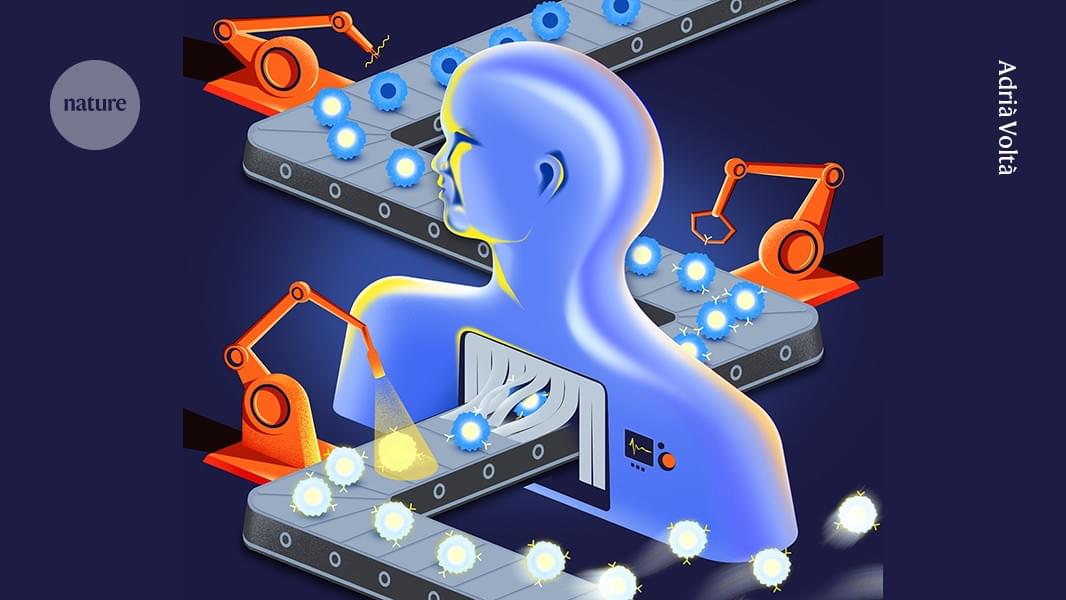The refillable eye implants continuously deliver a customised formulation of a drug over a period of several months.
The GHZ paradox was introduced in 1989. It highlights the mismatch between classical viewpoints and the quantum description of reality.
Sodium–air fuel cells could unlock electric flight and clean transit, capturing CO₂ and outperforming lithium batteries.
Learn how to increase testosterone naturally with 8 proven biohacks. Backed by science, optimized for energy, strength, and mood. No meds. No fluff.
Manufacturing CAR T cells in the laboratory is expensive and time-consuming. An in vivo approach could get the powerful therapy to more people.
Join Territory: https://www.youtube.com/channel/UC8SGU9hQEaJpsLuggAhS90Q/join.
Research paper: https://academic.oup.com/mnras/article/538/1/76/8019798?login=false.
The James Webb Space Telescope has revealed ancient galaxies that appear far too massive and mature for their age, challenging our current understanding of cosmic evolution. These galaxies, observed just 330 million years after the Big Bang, should be small and irregular. Instead, they are well-formed and massive, suggesting that something fundamental about our models of the early universe may be incomplete.
One radical theory proposes that our universe could be the interior of a black hole in a larger parent universe. In this model, the Big Bang was not an explosion in empty space but the moment matter collapsed into a black hole, creating a new cosmos inside. The event horizon of this black hole would act as a boundary, beyond which everything—including time—behaves differently from an outside perspective.
Recent observations also suggest that the universe might have a preferred axis, contradicting the assumption that the cosmos is isotropic. The surprising alignment of galaxies on a large scale hints at unknown forces or structures shaping the universe. If true, this could support the idea that our universe is not an isolated system but is influenced by a larger framework, possibly the structure of a black hole’s interior.
Some theories also suggest that black holes could generate new universes through a process called a “big bounce,” where extreme torsion at high densities prevents a singularity from forming. Instead of collapsing to an infinitely small point, matter could rebound, triggering expansion. If our universe formed in such a way, it could explain why physical constants seem fine-tuned for life—because only stable, self-sustaining black hole universes would persist.
This docu-series covers all three of Earth’s next landing options – Asteroids, the Moon and Mars. The programmes explore the scientific reasons for and against each celestial body’s case to be the next that humans might colonise. They explore the technical and logistical problems and benefits of each – EG temperature at night and day, ability or inability to harness solar power and more.
Join the Spark Channel Membership to get access to perks:
/ @sparkdocs.
Watch the best history documentaries, with 50% off your first 3 months, on History Hit: https://historyhit.com/subscribe Using the code SPARK
Find us on:
Facebook: / sparkdocs.
Instagram: / spark_channel.
Any queries, please contact us at: [email protected].
An AI scanning billions of particle collisions at CERN’s Large Hadron Collider has detected something extraordinary — a mysterious particle decay at 4.8 TeV that doesn’t match any known physics. While scientists aren’t calling it official yet, this anomaly could be our first glimpse of a fifth fundamental force of nature.
🔬 What We Cover:
The real AI discovery behind the viral headlines.
How machine learning found what human scientists missed.
Why this 2.9-sigma anomaly has top physicists watching closely.
The miracle of life. A 40-week process where you developed from a single cell to fully formed human baby. All within in your mother’s womb. Now, imagine you were born in an artifical womb. How would we benefit from artificial wombs? What would be the downsides?
Transcript and sources: https://whatif.show/what-if-we-could–… our Patreon community and help make What If better: http://bit.ly/whatif-patreon Watch more what-if scenarios: Planet Earth: • What If Earth Was in Fact Flat? The Cosmos:
• Video Technology:
• What If the Sahara Desert Was Covered With… Your Body:
• What If You Were Born on a Space Station? Humanity:
• What If You Were the Last Person on Earth? Tweet us your what-if question to suggest an episode: http://bit.ly/whatif-twitter What If elsewhere: Instagram: http://bit.ly/whatif-instagram Twitter: http://bit.ly/whatif-twitter Facebook: http://bit.ly/facebook-whatif What If comes in other languages! What If in Spanish: http://bit.ly/YT-Spanish-what-if What If in Mandarin: http://bit.ly/YT-Chinese-what-if Suggest an episode (detailed): http://bit.ly/suggest-whatif T-shirts and merch: http://bit.ly/whatifstore Feedback and inquiries: https://underknown.com/contact/ What If is a mini-documentary web series that takes you on an epic journey through hypothetical worlds and possibilities. Join us on an imaginary adventure — grounded in scientific theory — through time, space and chance, as we ask what if some of the most fundamental aspects of our existence were different.
Join our Patreon community and help make What If better: http://bit.ly/whatif-patreon.
Watch more what-if scenarios:
Planet Earth: • What If Earth Was in Fact Flat?
The Cosmos: • Video.
Technology: • What If the Sahara Desert Was Covered With…
Your Body: • What If You Were Born on a Space Station?
Humanity: • What If You Were the Last Person on Earth?
Tweet us your what-if question to suggest an episode: http://bit.ly/whatif-twitter.
What If elsewhere:
Iceland approved the 4-day workweek in 2019, nearly 6 years later, all the predictions made by Generation Z have come true
Posted in business, economics, law, singularity | Leave a Comment on Iceland approved the 4-day workweek in 2019, nearly 6 years later, all the predictions made by Generation Z have come true
Fewer hours. Same pay. Possible approach to the Economic Singularity?
In 2019, Iceland made headlines by becoming one of the first countries in the world to adopt the four-day working week, not through a general law, but through agreements allowing workers to negotiate shorter weeks or reduced hours. Five years on, the results are indisputable.
The Icelandic experiment began in 2015 with a pilot phase involving around 2,500 employees, or just over 1% of the country’s working population. Following the resounding success of this initiative, with 86% of the employees involved expressing their support, the project was formalised in 2019. Today, almost 90% of Icelandic workers benefit from a reduced working week of 36 hours, compared with 40 hours previously, with no loss of pay.
Initial concerns about the four-day week were widespread, both in Iceland and elsewhere in the world. There were fears of a drop in productivity, increased costs for businesses and difficulties in adapting to maintain service levels. However, the Icelandic experience has swept these fears under the carpet.








